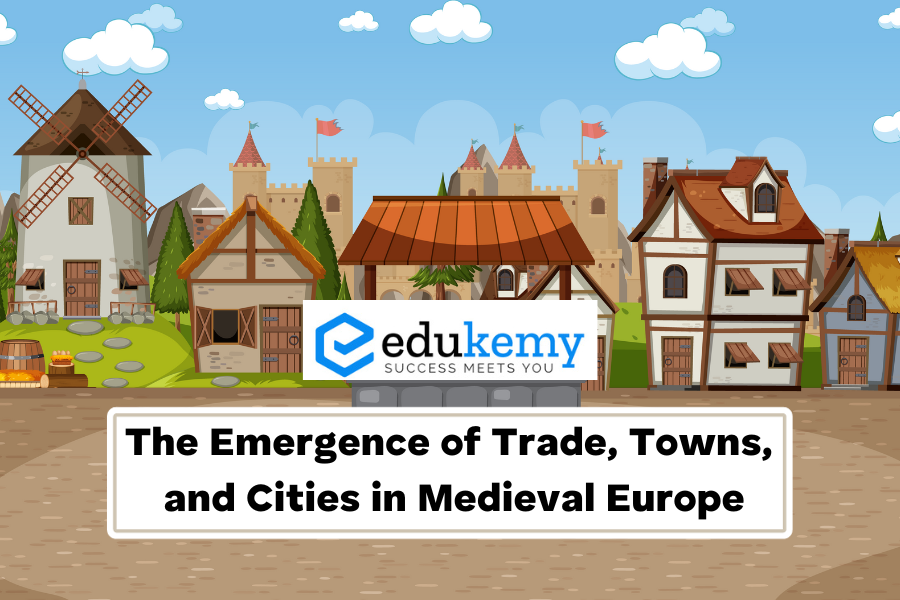
The rise of trade, towns, and cities in medieval Europe was a significant development that transformed the economic and social landscape. Several key factors contributed to this transformation:
- Contact with the Arabs during the Crusades:
- In the 7th century, the Crusades brought Europe into contact with the Arab world, exposing Europeans to the rich and advanced Arab civilizations. This contact increased the demand for luxury goods from the East among European lords.
- Agricultural Productivity and Peasant Buyers:
- Advances in agricultural methods led to increased productivity, allowing peasants to have more surplus income. As a result, they became buyers of non-agricultural goods, further stimulating trade.
- Rise of Crafts and Towns:
- The increased demand for goods gave rise to crafts and artisanal production. Towns where these crafts were produced became increasingly important.
- Emergence of Towns and Cities:
- The 11th century marked a period of rapid urbanization, with towns growing into cities. Peasants gradually transitioned into artisans, and merchants began to settle in these growing towns.
- Development of Trade Routes:
- Towns and cities developed along both land-based trade routes and sea ports. Ports played a crucial role in importing goods from Asia, which were then transported along overland routes to mainland Europe.
- Italian City Development:
- Italy, with its favourable geographical location and natural harbours, witnessed significant city development. Sea-port cities like Venice and Genoa became prominent trading hubs due to their strategic locations and ease of trade with the East.
- Continued Prosperity:
- The seaports and inland trade centres that developed during this period continue to be thriving cities in modern Europe, reflecting the enduring impact of this medieval transformation.
The emergence of trade, towns, and cities in medieval Europe not only boosted economic activity but also led to social and cultural changes. These urban centres became hubs of commerce, culture, and innovation, contributing to the development of the modern European landscape.
Contents
- 1 Frequently Asked Questions (FAQs) about The Emergence of Trade, Towns, and Cities in Medieval Europe
- 1.1 1. FAQ: What factors contributed to the emergence of trade in Medieval Europe?
- 1.2 2. FAQ: How did towns develop in Medieval Europe, and what was their significance?
- 1.3 3. FAQ: What role did guilds play in the economic structure of Medieval European towns?
- 1.4 4. FAQ: How did the growth of cities impact Medieval European society and governance?
- 1.5 5. FAQ: What were the key factors that led to the decline of trade and urban centers in Medieval Europe?
- 2 In case you still have your doubts, contact us on 9811333901.
Frequently Asked Questions (FAQs) about The Emergence of Trade, Towns, and Cities in Medieval Europe
1. FAQ: What factors contributed to the emergence of trade in Medieval Europe?
Answer: Trade in Medieval Europe was influenced by several factors. The revival of long-distance trade routes, such as the Silk Road, after the fall of the Roman Empire played a crucial role. Additionally, the growth of a money economy, the establishment of market towns, and the rise of a merchant class all contributed to the flourishing trade during this period.
2. FAQ: How did towns develop in Medieval Europe, and what was their significance?
Answer: Towns in Medieval Europe developed around marketplaces and trade routes. The growth of trade and commerce led to increased urbanization as people gathered in these central locations for economic opportunities. Towns became vital hubs for cultural exchange, craftsmanship, and the development of a more structured society.
3. FAQ: What role did guilds play in the economic structure of Medieval European towns?
Answer: Guilds were associations of skilled craftsmen in Medieval European towns, organized to protect the interests of their members. They played a crucial role in regulating trade, setting quality standards, and providing training for artisans. Guilds contributed to the economic stability of towns by fostering a sense of community and ensuring fair competition.
4. FAQ: How did the growth of cities impact Medieval European society and governance?
Answer: The growth of cities in Medieval Europe led to significant social and political changes. Cities became centers of political power, with the emergence of city-states and municipal governments. The concentration of people in cities also contributed to the development of a more complex social structure, with the rise of a middle class and the gradual weakening of feudal structures.
5. FAQ: What were the key factors that led to the decline of trade and urban centers in Medieval Europe?
Answer: Several factors contributed to the decline of trade and urban centers in Medieval Europe. The Black Death, a devastating pandemic in the 14th century, led to a significant loss of population, disrupting economic activities. Additionally, the shift in trade routes due to geopolitical changes and the decline of feudalism also played a role in the decline of trade and the contraction of urban centers during this period.
In case you still have your doubts, contact us on 9811333901.
For UPSC Prelims Resources, Click here
For Daily Updates and Study Material:
Join our Telegram Channel – Edukemy for IAS
- 1. Learn through Videos – here
- 2. Be Exam Ready by Practicing Daily MCQs – here
- 3. Daily Newsletter – Get all your Current Affairs Covered – here
- 4. Mains Answer Writing Practice – here

